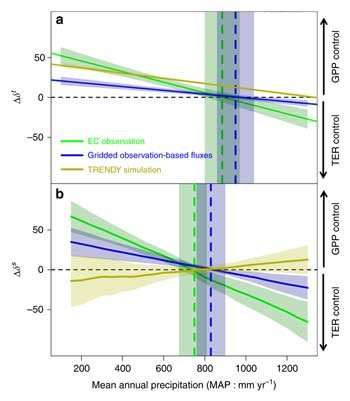Researchers find precipitation thresholds regulate carbon exchange

One of the major sources of uncertainty about the future climate is whether ecosystems will continue to take up carbon dioxide or release it to the atmosphere. University of Montana researchers and co-authors confronted this problem using atmospheric measurements and satellite observations to test model simulations in a recent study published on Sept. 5 in Nature Communications.
W.A. Franke College of Forestry and Conservation Research Scientist Zhihua Liu and colleagues compared atmospheric measurements and satellite observations to climate change model simulations to help better predict terrestrial carbon dynamics across the contiguous United States.
Ecosystems either soak up carbon through photosynthesis—a negative feedback that could reduce future warming—or release it through respiration—a positive feedback that could enhance future warming. Understanding how climate change might impact ecosystem photosynthesis and respiration is critical for predicting future carbon dynamics.
Liu's team discovered that whether ecosystems across the U.S. uptake carbon or release it is dependent on water availability. The primary control switches from production to respiration at an annual precipitation threshold between 30 and 35 inches in the contiguous United States. The carbon balance of ecosystems in the dry West is very sensitive to photosynthesis. In contrast, the carbon balance of more mesic Eastern U.S. ecosystems is more sensitive to carbon lost through respiration.
However, climate models do not reflect this precipitation threshold. Liu and his co-authors determined that these models are far too sensitive to photosynthesis and not sensitive enough to respiration, suggesting the Earth's ecosystems may lose more carbon to the atmosphere in the future as surface temperatures continue to warm.
"In different regions, the interannual variation of net carbon uptake is primarily impacted by different processes—respiration or photosynthesis," Liu said. "To me, the most important part of this study is that the models need improvement on respiration."
Co-author and UM bioclimatology Associate Professor Ashely Ballantyne adds, "This study suggests we know more about the negative feedback loop and less about the positive one."
More information: Zhihua Liu et al, Precipitation thresholds regulate net carbon exchange at the continental scale, Nature Communications (2018). DOI: 10.1038/s41467-018-05948-1
Journal information: Nature Communications
Provided by University of Montana















